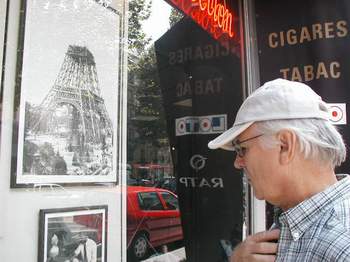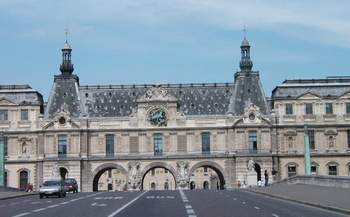 |
This place never ceases to amaze me. Take
this snap dragon, at left, for example. Here we are, in the hottest summer ever in
France, and somehow this little flower takes root and grows in a tiny crack where a stone
wall meets a sidewalk. How did it ever survive, I wonder? It must have
something to do with the little green men who wash the sidewalk and gutters almost every
day. A bit of water must seep into the crack and stay. This tough little guy
lives on the sidewalk along the rue de Presles, approximately across the street from the
downtrodden Cuban embassy. Many human organisms did not survive the heat wave. It may seem like I'm dwelling on the canicule too much, but it was the number one event of the summer, according to 60 percent of the French people. (Source: a poll conducted by CSA for Le Parisien.) The number of deaths related to the canicule is now reaching 13,600 for the whole of France. There is still a huge backlog of bodies to be buried. A large fruit and vegetable warehouse on the outskirts of Paris is still being used to keep bodies cool until they can be buried. |
 This nice cat was under a car on avenue Rapp yesterday. When I walked by, it came out to see if I was really a cat person. |
This new, larger number is a result of information
released by Hugues Fauconnet, the general delegate for the Ile de France for Pompes
funèbres générales (PFG). This association of funeral parlors represents about a
fourth of the funeral market in France. Hugues says that PFG has an excess of 2604
deaths (compared to other years) for the first three weeks of August. Multiply
that times 4 and you get about 10,400. However, the pompes funèbres OGF, number one in this business in France, estimates that the total number of "supplementary" deaths, attributable to the heat wave, is 13,632, including 3,325 in the Paris region. The City of Paris's funeral services estimate a higher number for the Paris region: 5,000. When asked if these numbers have been transmitted to the authorities, Hugues says that nobody has asked for them, but his organization has indeed sent the figures to the Ministry of the Interior (Nicolas Sarkozy's turf). |
 Nice cat smells my hand, and then starts rubbing himself all over my hand, arm, camera. Very affectionate. Healthy, non-neutered, young, hefty male cat. He is spooked when someone with a briefcase walks by. |
The priests are very overworked. Father Ribalet of the Saint Denis cathedral in Essonne (suburb south of Paris) told Le Parisien, "We have had ten burials in ten days. This is much more than in normal times! And it is not only the older people who died. Friday, I conducted a service for a 44-year-old who died from the canicule! The funeral parlors don't stop calling me; I am really overwhelmed." If you are amazed at how these numbers have grown, you're in plenty of company. Le Parisien outlines the growth in the mortality numbers from the end of the first week of August: August 8 - Fourteen deceased due to the heat are certified in France. August 10 - E.R. doctor Patrick Pelloux sounded the alarm to the media [after being ignored by the authorities for a few days]. At this point, Dr. Pelloux speaks of 50 deaths. August 11 - The OGF funeral services assess 500 as the number of supplementary deaths in one week. August 14 - Le Parisien and Aujourdui en France publish their own evaluation realized by calling town halls [there is one for each arrondissement in Paris], city hall, hospitals, and retirement homes. They estimate the number as at least 2,000 deaths in the Paris region. Lucien Abenhaim, roughly the equivalent of the Surgeon General for France, announces a number of 3,000 deaths for the whole country, a number that the Minister of Health (professor Mattei) relates later in the day as "between 1500 and 3000 victims." August 17 - The number of 5,000 deaths is put forth by the government, but it is denied by professor Mattei who prefers "official numbers" above. August 18 - Professor Mattei affirms that the number of 5,000 victims is "plausible." August 20 - OGF funeral services publishes their own estimate of more than 13,000 deaths for the whole of France. 82 percent of the victims were over 75 years old. 50 percent died in retirement homes, 30 percent in the hospital, and 20 percent in their own homes.
|
 After a brief retreat under the car, a narrow escape from Briefcase Man, nice cat emerges to be petted by another cat lady. |
|
 |
There is a symbolic figure called
"Marianne" that represents the people of France; she is classically
depicted as a woman with a sort of helmet/hat. I may have already mentioned this display, on the front of the National Assembly building, of modern day Mariannes. The info I had at the time was that this was to promote the idea of the diversity (racially, ethnically) of the people in France. Well, it is more than that. The real purpose of this campaign is to help poor women, particularly those in the housing projects on the outskirts of Paris. These women, often immigrants from African countries that France once colonized, are too many times the victims of violence due to their native cultures' inclinations to repress the rights of women. |
 Nice cat returns to me for more affection. |
This Marianne publicity campaign is intended to
send a message to these women: You are French first, and you have all the rights
that all French women have. You do not have to put up with violence and oppression. The violence and oppression generally originates from religious extremist groups. You know the score.
Another interesting story in today's Le Parisien: During the recent blackout in New York City, a 66-year-old retired French engineer named Mr. Luu was visiting the Big Apple with his wife. While his wife was buying tickets to go up to the top of the Empire State Building, he waited in the hall. The blackout happened. He was carried with the crowd out onto the street, separated from his wife. He suffers from Parkinson's disease, and during times of extreme stress, he loses his memory. He does not speak any English, and he has no identification papers on him. He has only 10 euros in his pocket. |
 Tom studies pictures of the Eiffel Tower under construction. |
He somehow succeeded in telling some people that
he wanted to go home, to Paris. He was taken, on that Friday, to La Guardia.
Once there, he was visibly suffering from dehydration and disorientation and so was taken
to a hospital in Queens. Meanwhile, Mrs. Luu spent the night in the Empire State Building. She tries to find her husband in the morning. She calls her family back in France to try to find him. After contacting the police, the French consulate, and some homeless shelters, the family put up posters in Chinatown (Mr. Luu is originally from Asia). Finally, a member of the nursing staff at the hospital in Queens made the connection between the patient without identification papers and the report of the missing Mr. Luu on the local TV station. He contacted the police and the TV station, and a little later, the Luu family was informed. They went to find him. Still in a state of shock, he nevertheless recognized his family immediately. Yesterday mid-day, he left the hospital and is on his way home.
|
 |
Tom and I went out for a 3-hour walk yesterday,
going along the left bank of the Seine, all the way from our neighborhood to the Gare
d'Austerlitz on the other side of Paris. It was a spectacularly beautiful day,
positively autumnal. When we arrived home, we were surprised to see that my cousin Geoff was still there. He spent the night with us the night before, but he checked into his housing at the Cite Universitaire. He'll be working as a P.R. person for the World Championships at the Stade de France this week. We thought for sure he'd rather be hanging around all those world-class athletes instead of his boring older cousin and her husband. But there he was, writing his e-mail. So he stayed for a few more hours and went to dinner with us at Le Champêtre (rue Saint-Charles). He and I had the crab ravioli, and I had fish for my main course. Tom and Geoff had veal medallions for their main courses. Tom had his usual apple tart flambée with calvados, and Geoff had crepes that were also served flambée. Geoff and I shared a nice gamay beaujolais. The sauce on the crab ravioli was one of those super-rich, buttery, creamy French sauces. I talked to Geoff about how these kinds of sauces are made. The meal was very, very good. Not bad for a resto that is a part of a small chain. |
 |
Across the street from the National Assembly building on the left bank, I took this shot of the obelisk at the Place de la Concorde. Notice Sacre Coeur on the horizon (two little white domes). The air pollution is a bit elevated still, but with the cool, refreshing breeze, it doesn't seem so bad. French people are starting to come back from vacation, and traffic on the city's streets is increasing day by day. The frenzied pace of Parisian life is slowly returning. |
 |
Here's the Louvre again, as seen from the left
bank in the middle of the Pont du Carrousel. We are so very sad to learn about the deaths in Iraq at the UN building in Baghdad. The UN envoy who was killed, Sergio Vieira de Mello, was educated in a french-brazilian school and had a doctorate from the Sorbonne. Le Monde reports that he spoke perfect French, without an accent. That paper contained an absolutely glowing, lengthy obituary for Mr. de Mello today. What a loss for humanity. |
| <Previous Next> |
